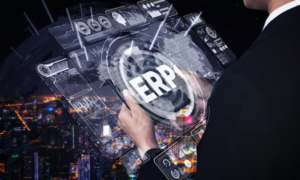Introduction
hris.balitteknologikaret.co.id | Apparel ERP – The apparel industry is a fast-paced, ever-evolving sector that demands efficient management to stay competitive. Apparel companies, whether involved in manufacturing, distribution, or retail, need to handle diverse and intricate operations. This is where Apparel ERP (Enterprise Resource Planning) software steps in. In this extensive guide, we’ll explore the world of Apparel ERP, uncovering its significance, features, benefits, challenges, and how it is transforming the apparel industry.

Understanding ERP and Its Role in Apparel Industry
Before delving into Apparel ERP, it’s essential to grasp the concept of ERP and its crucial role in the apparel sector.
1.1 What is ERP?
ERP, or Enterprise Resource Planning, is a software solution designed to streamline and centralize various business processes, including inventory management, supply chain management, financials, human resources, and more. It provides a unified platform where data from different departments can be integrated and accessed in real-time, enhancing efficiency and visibility.
1.2 The Role of ERP in the Apparel Industry
In the apparel industry, ERP plays a pivotal role in managing the complexities of the business. It helps apparel companies:
- Manage Inventory: Tracking raw materials, work-in-progress items, and finished goods is crucial in the apparel industry to avoid overstocking or stockouts.
- Optimize Supply Chain: Apparel ERP systems streamline the supply chain by enhancing visibility and coordination with suppliers, reducing lead times, and ensuring timely deliveries.
- Control Finances: Managing financial aspects such as accounting, payroll, and budgeting is essential for the financial stability of apparel companies.
- Handle Human Resources: From payroll and attendance management to employee performance, ERP systems help HR departments run efficiently.
- Enhance Customer Service: By providing real-time information on orders and deliveries, ERP systems enable apparel companies to offer superior customer service.
The Essentials of Apparel ERP
Apparel ERP systems are specifically designed to cater to the unique needs of the industry. In this chapter, we’ll explore the key features that define Apparel ERP.
2.1 Inventory Management
Inventory management in the apparel industry is intricate, with multiple SKUs, sizes, and styles. Apparel ERP offers tools to efficiently track, manage, and optimize inventory, reducing the risk of overstocking or stockouts.
2.2 Supply Chain Management
Efficient supply chain management is essential in the apparel industry to ensure the timely delivery of products. Apparel ERP systems provide visibility into the supply chain, allowing for better coordination with suppliers and distributors.
2.3 Product Lifecycle Management
In the apparel industry, product lifecycle management is vital. Apparel ERP solutions help in managing the entire lifecycle of a product, from design and production to distribution and sales.
2.4 Financial Management
Financial management tools within an Apparel ERP system enable companies to handle accounting, payroll, budgeting, and financial analysis efficiently.
2.5 Order and Demand Management
Apparel ERP software facilitates the management of customer orders and demand forecasting, ensuring that companies can meet customer demands effectively.
2.6 Reporting and Analytics
Robust reporting and analytics features provide valuable insights into business performance, enabling data-driven decision-making.
Benefits of Apparel ERP
Apparel ERP systems offer numerous advantages to businesses in the industry. Let’s explore these benefits in detail.
3.1 Improved Efficiency
Efficiency is paramount in the apparel industry. Apparel ERP automates manual tasks, streamlines operations, and reduces errors, resulting in enhanced efficiency.
3.2 Enhanced Visibility
Apparel ERP provides real-time data, offering improved visibility into all aspects of the business. This transparency enables better decision-making and rapid responses to changing market conditions.
3.3 Cost Reduction
By optimizing inventory management, reducing lead times, and improving overall efficiency, Apparel ERP can lead to significant cost reductions for businesses.
3.4 Scalability
Apparel ERP systems are scalable and can grow with your business. Whether you’re a small start-up or a large enterprise, the system can adapt to your needs.
3.5 Competitive Advantage
Having a streamlined and efficient operation with the help of ERP provides a competitive advantage in the fast-paced apparel industry.
Challenges in Implementing Apparel ERP
While Apparel ERP offers a host of benefits, it’s not without its challenges. Here, we explore common hurdles and strategies to overcome them.
4.1 Data Migration
Challenge: Migrating existing data to a new ERP system can be complex and risky. Solution: Carefully plan and execute data migration, ensuring data accuracy and minimizing downtime.
4.2 Employee Training
Challenge: Getting employees accustomed to a new system can be challenging. Solution: Invest in comprehensive training programs to ensure a smooth transition.
4.3 Customization
Challenge: Apparel companies often have unique processes and requirements. Solution: Work with ERP vendors who offer customization options to tailor the system to your specific needs.
4.4 Integration
Challenge: Integrating ERP with other software and systems can be complex. Solution: Engage with experienced consultants who specialize in integrations to ensure a seamless process.
4.5 Data Security
Challenge: Protecting sensitive data is critical, especially in the apparel industry. Solution: Implement robust data security measures and choose ERP systems that prioritize data security.
Apparel ERP Implementation Process
A successful implementation of an Apparel ERP system involves careful planning and execution. Here is a step-by-step guide for implementation.
5.1 Needs Assessment
Begin by assessing your organization’s specific needs. Understand the unique requirements and challenges of your apparel business.
5.2 Vendor Selection
Select an ERP vendor that specializes in apparel industry solutions and offers features that align with your needs.
5.3 Data Preparation
Clean and prepare your data for migration. This step is crucial to ensure data accuracy and integrity.
5.4 Training
Invest in training programs to familiarize employees with the new ERP system. Training ensures a smoother transition.
5.5 Testing
Thoroughly test the ERP system before going live to identify and resolve any issues.
5.6 Go-Live
Execute the implementation and go live with the ERP system. Monitor the system closely in the initial stages to address any emerging issues.
5.7 Post-Implementation
After the system is live, continue to monitor its performance and gather feedback from users. This will help in fine-tuning and optimizing the system.
Future Trends in Apparel ERP
The future of Apparel ERP holds exciting possibilities. Here are some trends to watch for:
6.1 Mobile ERP
As the business world becomes increasingly mobile, expect mobile ERP solutions that allow users to access data and perform tasks from smartphones and tablets.
6.2 AI and Machine Learning
Artificial intelligence and machine learning will play a significant role in Apparel ERP, offering advanced analytics, automation, and predictive capabilities.
6.3 Sustainable ERP
Sustainability is a growing concern in the apparel industry. Future ERP systems may incorporate sustainability features to track and manage eco-friendly practices.
6.4 IoT Integration
The Internet of Things (IoT) is making waves in the apparel industry. Apparel ERP systems may integrate with IoT devices to offer real-time data from wearables and connected products.
6.5 Enhanced Analytics
The analytics capabilities of ERP systems are likely to become more advanced, providing deeper insights and actionable intelligence.
Conclusion
Apparel ERP is a game-changer for the apparel industry. Its ability to streamline operations, enhance efficiency, and provide real-time data visibility is essential in a sector known for its fast pace and intricate operations. By understanding the essentials of Apparel ERP, its benefits, challenges, and the implementation process, apparel companies can leverage this technology to stay competitive and thrive in the evolving landscape. As the apparel industry continues to embrace technology, Apparel ERP is set to play a central role in reshaping the way businesses manage their resources and deliver quality products to customers worldwide.




